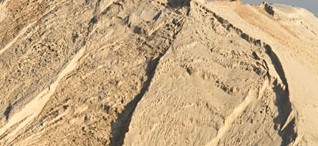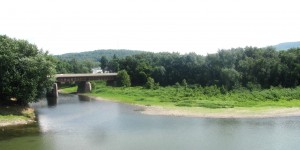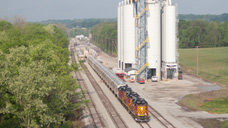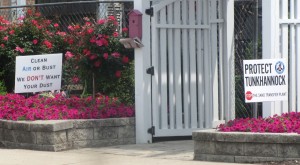Photo and Editorial by Rick Hiduk
The Wyoming County Planning Commission recently turned down a proposal by D&I Silica LLC to construct a sand transfer station along the Susquehanna River in Tunkhannock Township.
A proposal for a silica transfer station presented to the Wyoming County Planning Commission early in 2014 became a prickly pear that may have more than a little bit of sting left in it. The decision by the majority of the board members present at a July 16 meeting to deny D&I Silica the right to construct a sand transfer facility along the railroad tracks on a vast vacant lot could potentially put tax payers on the hook for thousands of dollars in legal fees.
It’s no secret nor an anomaly that the county’s Comprehensive Plan is grossly outdated. The complexities of the natural gas business took many counties and municipalities in the Endless Mountain off guard. Every borough council, board of supervisors, and trio of county commissioners in the state has scrambled to secure some sort of protection for their constituents. Work only recently began in Wyoming County to revamp the Plan, which is close to 20 years old.
In Wyoming County, the only governing tool the Planning Commission has to work with is the SALDO (sub-division and land development ordinance). It has been amended at least three times since 2010. Changes have addressed compressor stations, pipelines, and setbacks. There are no provisions of the SALDO that D&I didn’t meet nor questions and concerns from local citizens and business owners for which the company’s representatives didn’t provide responses or resolution.
Frustrated by the county’s apparent inability to stop the sand plant under the wording of the existing SALDO, a number of people at the meeting who were aided and coached by representatives of an outside group – namely the Community Environmental Legal Defense Fund – descended on the Planning Commission on July 16 as the board was about to vote on the proposal.
It should be noted that the board table was less than full. There were people who chose to sit this meeting out who might have changed the outcome and/or felt compelled to hold their fellow board members to the wording of the SALDO, which includes “No provision in this Ordinance shall be construed to deny the right of any property owner to use and develop his land as may be permitted under the Ordinance.”
At the meeting, County planner Nicole Wooten assured the board that D&I had fulfilled all requirements, including having all permits in hand. That is unfortunately not always the case in Wyoming County. Several recent development projects have proceeded to the point of Grand Opening celebrations prior to having full approval from the Planning Commission to even construct a business. But D&I had all of their ducks in a row, as per the current and legal SALDO.
Apparently six board members qualifies as a quorum, and four of them voted against granting D&I preliminary approval for construction of a state-of-the-art facility that takes sand from choo-choo trains, puts it in trucks that then take the sand to natural gas pads, where it is mixed with water, natural lubricants, minute amounts of solvents and anti-bacterial agents to blast cracks into the Marcellus shale for gas extraction.
A quick review of America’s industrial history naturally leaves one with concerns about accidents, but these potential threats are new to many of us in this region who experienced economic decline for the first half of our lives. Attacking a benign aspect of an industry that nobody can stop is a waste of time. There are still many elements of the gas industry that need our attention and that of our elected officials. I assure you that dangers much greater than you fear about a sand transfer site exist in the gas fields themselves and require more vigilant monitoring.
But the truth about those much more dangerous aspects of gas drilling is that there is as much regulation, protocol, and discipline invested in the prevention of such mishaps as there would be at a new sand transfer station. It’s sand, for crying out loud. Yes, it is eventually used for fracking, but it is all but benign at its source. This reminds me of people freaking out about early ruptures and flow backs of bentonite, which is natural clay. It has been used to safely line wells and other aquifers for millennium and is a key ingredient in kitty litter.
In an article written by Bob Baker in the Wyoming County Press Examiner about the meeting, concerns were cited about the possibility of little league baseball players playing nearby contracting Silicosis. This tactic was used by protesters in Wyalusing two years ago when they suggested via YouTube videos that the sand transfer station there would make all of the kids at the adjacent day care sick. Independent studies procured by both the sand station and the day care proved that there was no inherent danger from moving sand from Point A to Point B.
The finest of sand is as pesky as any other airborne dust, and employees at sand facilities probably face long-term risks, as men and women across America do every day at equally important jobs. Farmers are subjected to dangerous fumes and come into contact with chemical compounds every day that can produce long-term health issues, and the runoff from their farms – if not mitigated – can enter watershed and have detrimental effects on wildlife and recreation. But we certainly don’t want to shut down farms.
The concern expressed by somebody at the meeting that the proposed facility might cause a malfunction at the nearby railroad crossing at Routes 6 and 29 and result in a traffic merits more discussion and planning. I understand that there have been some back up and signal issues at the crossing, that the signal issues were resolved, and D&I would obviously have to work closely with the railroad and PennDOT to reduce any impact on traffic there. Frankly, however, there are idiots at that crossing every day that sit on the tracks regardless of the signage. Stupidity will always be the most common cause for accidents.
I have visited several sand transfer facilities and active gas drilling sites in the past four years. At any active work site, I watch my footing, wear protective gear, and listen very closely to the instructions of my guide. There was never anything at a sand plant that made me feel uneasy or threatened. The sense of potential danger or injury on an active gas pad, however, is unavoidable, if only due to the sheer weight of every tool and piece of machinery. If anything swings or jumps in the wrong direction, someone could be hurt.
As is the case with every aspect of the gas industry that I’ve had the opportunity to observe up close, the crew members are constantly aware of the potential for danger and do everything they can to avoid it. They are very concerned about their personal welfare, which leads me to believe that they have yours in mind as well. The protesters disagree. But it was the diligence of the earliest local advocates, when the gas companies arrived, that has had the most positive effect on safe well site practices. I am sure there is still much to be learned and improved upon, but advocacy will always trump protesting.
The citizen concern cited by Bob Baker in his article about the Planning Commission meeting that most piqued my interest was the suggestion that any fill brought into the construction site might increase flooding potential for the borough of Tunkhannock. Parts of downtown Tunkhannock were devastated by the 2011 flood, and speculation afterward that the (relatively new) bypass may have prevented Tunkhannock Creek from naturally draining into the river more quickly is a reasonable quandary. That said, those who protested the construction of CVS on what is technically the biggest damn between Tunkhannock Creek and the Susquehanna River to exist since the canals were right to do so.
The “natural” state of the river and the Tunkhannock Township flood plain was altered as soon as European settlers arrived here 200 years and evolved with no respect for flooding until recent years. Working with D&I’s engineers could provide the perfect opportunity to mitigate a potential disaster by channeling the overflow from Tunkhannock Creek under the highway and under or directly through the silica plant. Tran Z in Wyalusing survived the 2011 flood without polluting anything. All that washed away was sand. They got more.
Let’s not forget that the welfare of a community depends on good-paying jobs, which were previously scarce. I’m not convinced yet that D&I won’t win this bid to bring another viable industry to the area, but continued protesting that is more motivated by emotion than scientific evidence could result in no company wanting to start a business here and force smart young adults to leave the county as happened in the ’70s and ’80s. Seven jobs here, seven jobs there. It all adds up.
Simply put, there are much bigger things in life to fear than sand. Let’s put our ambitions into understanding how the industry works and making sure that it operates as the companies have committed and as existing laws permit. The pursuit of controlling the gas industry and its expansion is a reasonable endeavor, but let’s not hold progress back based on unfounded fears and the bitterness of not having been able to stop it from happening in the first place.
A sand transfer facility as pictured at www.highcrushpartners.com. Hi Crush Partners LP purchased D&I Silica LLC in 2013.
A downtown business owner posted signs protesting the sand transfer plant.




Well said.
Our group was not coached by CELDF. We discovered CELDF after the vote and the impending appeal. To say pure crystalline siica is benign is misleading. We based our opposition on scientific facts from the American Lung Association, American Academy of Pediatrics, NIOSH, CDC, OSHA and others. There has not been one study on ambient air exposure to pure crystalline silica and children, because it is used in an industrial process and children are not to be exposed to it in the first place. If you had attended the meeting, which I don’t believe you did, you would have known it had nothing to do with CELDF at that time. Based on the response from the Planning Commission Solicitor in the parking lot after the meeting, I searched for probono legal help. To say regulations as they currently stand will protect us is unfounded! The state of Wyoming is updating their regulations due to their experiences with this industry, asking for one mile well setbacks and hope to get at least 1/2 mile. Areas of Texas have 1000 to 1500 feet, yet PA allows the industry to write their own regulations? 7 jobs and they don’t require their employees to wear PPE, based on their own video that they showed at the meeting! If they don’t protect their employees will they care about our community?
Well…some taxpayers in Wyoming County are perhaps at a point with everything else that happens in this community, that we don’t mind that it may be necessary to spend some of our own money . We pay it in taxes so let’s put some of it to good use. There are those of us that may not look at it as being “put on the hook for thousands of dollars in legal fees”…but rather a small price we are willing to pay out to ensure that regulations for a safe and healthy community are put in place. It’s long overdue.